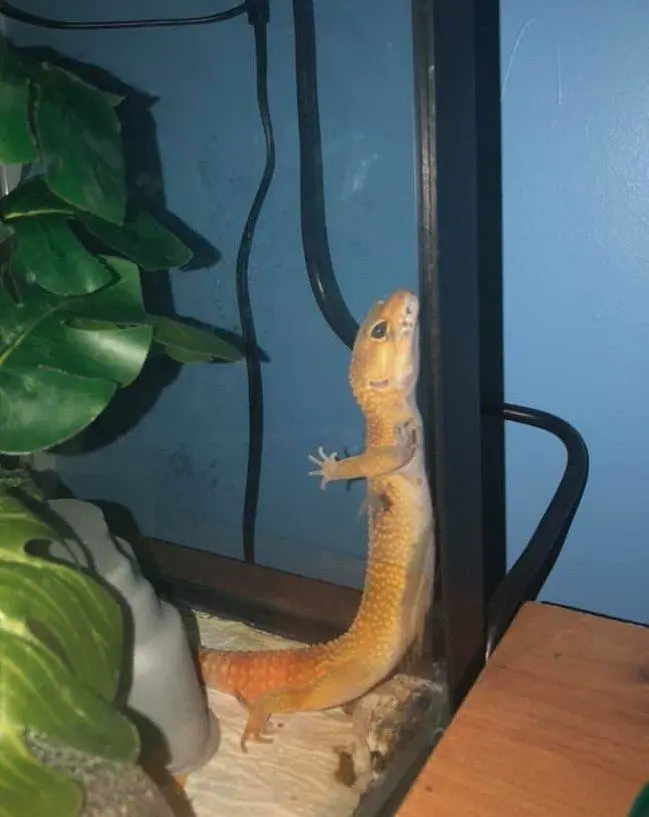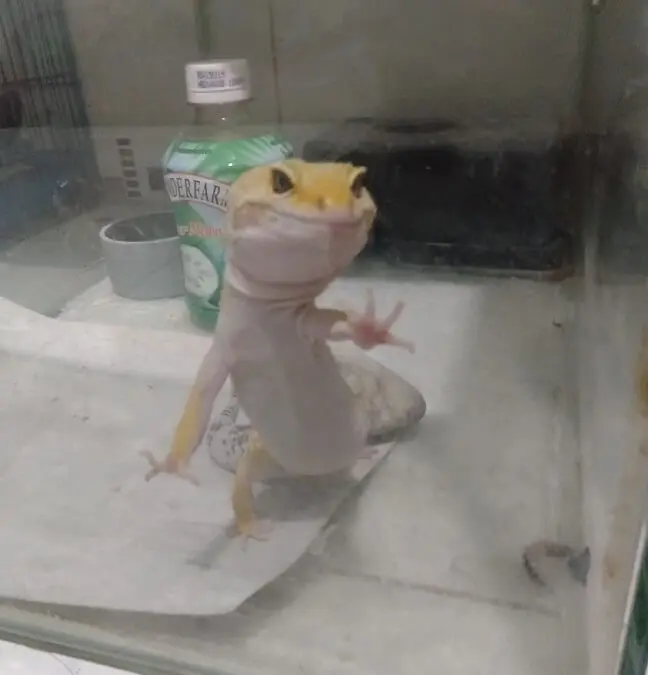It’s not uncommon for leopard gecko owners to see their reptiles dancing up against the glass of their enclosure, better known as glass surfing.
While you may think this is very cute, showing it off to friends and family, there are numerous reasons why your pet may be doing this.
Understanding glass surfing along with why your pet may be doing it is important, helping you make necessary changes as needed to ensure your pet remains happy and healthy.
What Is Glass Surfing In Leopard Geckos?
Glass surfing is when your leopard gecko tries to climb the side of the enclosure.
It looks like a dance with your pet’s belly rubbing on the glass as its legs paddle away. They stand on their hind legs and it looks as though they want to get out of the enclosure.

Why Is My Leopard Gecko Glass Surfing?
Many leopard gecko owners will tell you their theories on why your pet is glass surfing, all of them coming down to stress.
Glass surfing is a result of stress and there are numerous reasons why your leopard gecko may be stressed. Other than your pet being stressed, there are no medical reasons to be concerned about glass surfing.
If your pet isn’t eating, shedding, is lethargic and glass surfing, then it’s recommended to seek veterinary treatment, as your pet could be sick.
Small Enclosure
One of the most common reasons that your leopard gecko may be stressed and glass surfing is that the enclosure may be on the small side.
Leopard geckos are active and need space to move around, explore, hide and bask. An adult leopard gecko needs an enclosure that is at least 20 gallon.
Related – Best leopard gecko enclosures.
Shared Enclosure
If you have more than one leopard gecko in an enclosure, remember to increase the size of the tank to enable them to move around. Two females are a safer combination than two males, as males are territorial and will fight.
If you haven’t increased the enclosure size or you have more than one male in the tank, stress can become an issue, which can result in glass surfing.
New Enclosure / New Pet

If you have recently brought your leopard gecko home or you have recently increased its tank size, then you will notice stress and your pet glass surfing. Instinctively, leopard geckos fear change and things unknown.
It’s common for leopard geckos to glass surf when they are introduced to a new enclosure. Allow your pet some time to get used to its new surroundings.
New Decorations
As mentioned above, leopard geckos are not keen on change, so the new basking log you purchased or the new hide, may actually cause stress and take your pet some time to get used to it.
A drastic change can make the tank feel completely new.
To reduce stress, make small changes over a period of time, allowing your pet to adjust to its new surroundings a little easier.
Related – Best hides for leopard geckos.
Searching for Food
It’s important to adjust the amount you feed as your leopard gecko grows.
When your pet is hungry, its natural instinct tells it to hunt for food, which means getting out of the enclosure and escaping in search of the food it needs.
Baby and juvenile leopard geckos should be fed up to seven small crickets daily until they grow to around four inches. You should offer larger food every second day until they reach twelve months.
Adult leopard geckos should be fed up to seven large crickets two to three times a week. You can add mealworms to the adult diet.
Related – Leopard gecko growth chart.
Low Temperatures
Leopard geckos are from warm areas, such as Afghanistan, Iran, and western India. They have very specific temperature requirements.
When the enclosure gets too cold, they try to escape to get the warmth they need to regulate their body temperature. Remember that your pet needs warmth for its digestion to work properly.
Ideal temperatures should be:
|
Area | Temperature |
|---|---|
|
Basking area | 90°F – 95°F |
|
Warm side |
80°F – 85°F |
| Cool side |
75°F – 80°F |
Use a digital thermometer for accurate temperature monitoring. It will enable you to make necessary adjustments to ensure your pet remains comfortable and happy.
Seeing Its Reflection
Your leopard gecko, if male, is not going to like sharing its territory. It’s possible that it is seeing its own reflection in the glass. When it sees its reflection, it is presuming its another leopard gecko.
Add a background to the walls, which can help to prevent your pet from seeing its own reflection, putting an end to the glass surfing.
It is also possible your pet has seen something outside the enclosure it wants to get to and doesn’t see the glass. This results in it trying to get out, not understanding why it can’t get to what has sparked its interest.
How to Stop Glass Surfing
Check what size the enclosure is. Ensure the tank you choose is big enough for your pet to move around with comfort. Recommended tank size is at least 20 gallon.
Ensure you don’t put two male leopard geckos in one enclosure. You can put two females together or two females with a male if you want more than one or two pets in one enclosure. Remember to increase the size of the enclosure with each leopard gecko you introduce.
Use a digital thermometer to monitor the enclosure temperatures and ensure they remain at optimum.
Ensure you feed your pet according to their size and age. A rule of thumb is to feed adult leopard geckos up to seven large crickets or mealworms up to three times a week.
Add new decorations slowly, making small changes to reduce stress.
Allow your leopard gecko to get used to a new enclosure, which can take up to two weeks.
If your pet is glass surfing with other symptoms, such as not eating, lethargic, not pooping, or shedding, then schedule a visit to the vet for analysis and treatment.
Summary
In most cases you are able to fix glass surfing relatively easily, taking into account that stress is the most common cause of your pet dancing up against the glass.
Identify the cause of the stress and allow your pet time to adjust or remove the stress completely to reduce the risk of glass surfing.